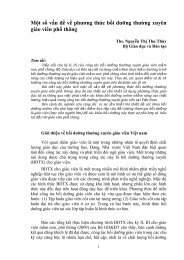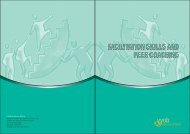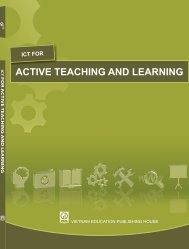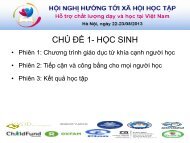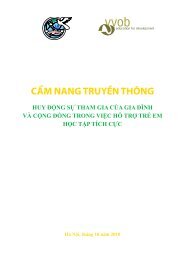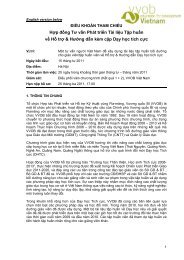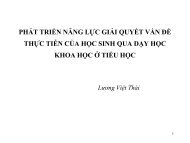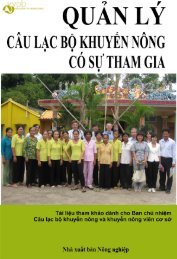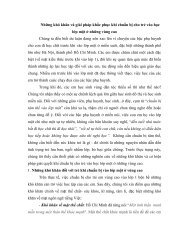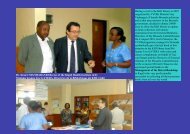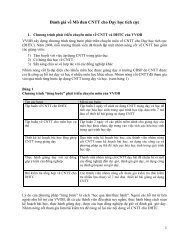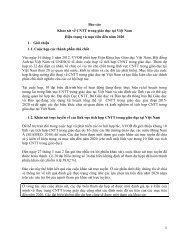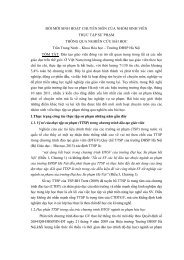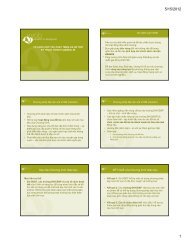Kenya Multi-Year Programme 2011-2013 - VVOB
Kenya Multi-Year Programme 2011-2013 - VVOB
Kenya Multi-Year Programme 2011-2013 - VVOB
- No tags were found...
Create successful ePaper yourself
Turn your PDF publications into a flip-book with our unique Google optimized e-Paper software.
4.3.4. Result orientation (effect and impact)It is important to recognize that it will be difficult to identify linear input-result-impact links in complexand open systems such as the education sector. <strong>VVOB</strong> does not work in a laboratorium withcontrolable variables. A certain level of flexibility during implementation was required in Phase I andwill still be necessary in the remaining period. <strong>VVOB</strong> has the advantage that it can align its programmewith the implementation of KESSP, but this means that the <strong>VVOB</strong> programme cannot be carried out ina clearly pre-defined, by <strong>VVOB</strong> controled arena.The above approach has also been used to achieve the expected results. Choice of operationalpartners has been important in this respect. Wider effect and impact cannot be achieved much withoutthis essential ―anchoring‖. Baseline studies for both strategic objectives were carried out in Phase I.The new programme period (second phase) will be used to achieve wider effect and assess impact.4.3.5. Internal efficiencyThe programme 2008-2010 gave direct support to a number of partner teams from MOEdepartments, semi-autonomous institutions, KESSP Investment <strong>Programme</strong> teams. The main featureof the programme was the input of human resources to increase the capacity of the various partners.During this period, <strong>VVOB</strong> employed four international and four national associates. These weresupplemented by various short term local experts. Given the shortage in education managers andother staff, at MOE Headquarters, the Ministry continues to request for specific technical assistance.Compared with the programme 2003-2007, the input of the <strong>VVOB</strong> staff has evolved to a facilitatingand advisory role. Whenever possible, the programme used MOE staff (from the various operationallevels) as facilitators or for expert input. Their capacity development has been one of the priorities ofthe programme.The programme also benefited from the involvement of three (<strong>Kenya</strong>n and Flemish) ―interns‖. Theseyoung graduates volunteered for up to six months. They gave specific technical input (eg oncommunication, website development, environment).The programme has been efficient in its use of programme funds, because they were directlymanaged by <strong>VVOB</strong>. As much as possible, the programme uses the MOE systems and guidelines, e.g,for transfer of funds to Healthy Learning schools and payment of per diem allowances. This hasincreased accountability.The programme 2008-2010 paid special attention to information sharing and communication,especially to the higher management levels. Reflection on lessons learned, knowledge managementhave improved compared with the previous programme 2003-2007. In the second phase, this effortwill be continued and strengthened for those areas with under-performance.Management and coordination was the responsibility of various implementing teams of the Ministryof Education, with <strong>VVOB</strong> representation. The orginal programme document described setting-up ofsteering committees and advisory committees for the programme. It was soon realized that thesesteering committees had a role to play in a project setting, but would not be efficient in a programmeapproach. Running these committees required involving education managers with little spare time –and they would create additional, unsustainable, management levels. Instead, existing chanels orexternal opportunities were used to obtain the advice and steering, when needed. The MOE SeniorManagement Team, in charge of managing MOE, has been regularly consulted and asked for steeringand approval. Fora with external experts were called (eg Water harvesting forum), when required.This approach has proven to be more efficient and effective and will be continued in the nextprogramme.In Phase I, both sub-programmes collaborated in relation to a number of outputs and activities. Thiswill be continued in the next programme, for example:The ICT Integration programme supports Healthy Learning for its monitoring database (to beintegrated in the MOE Management Information System), web-based reporting, increased use of e-<strong>Kenya</strong> - <strong>Multi</strong>-<strong>Year</strong> <strong>Programme</strong> <strong>2011</strong>-<strong>2013</strong> 24/148



